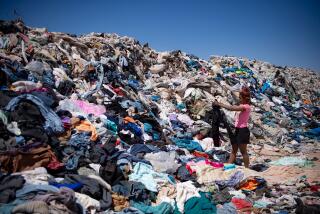Donated Clothing Goes from Rags to Riches for Recyclers
NEW YORK — Could your once-trendy bell-bottoms be wiping up a spill on a factory floor? That $200 cashmere sweater reincarnated into a pair of warm mittens? Or that comfy, old flannel shirt winging its way to Pakistan?
And you thought you gave your old clothes to the homeless.
Chances are, your donation will still raise money for a good cause, but the chain of events may not be quite as you envisioned. Some castoff clothing takes on a surprising new life.
In a red-brick warehouse in the Greenpoint section of Brooklyn, 100,000 pieces of used clothing are processed daily--as many as can be found on the selling floor at Macy’s, which bills itself as the world’s largest store.
About 95 employees toss, sort and bale the 35 tons of garments and shuffle them through an elaborate system of chutes and conveyor belts. By the end of the day, the multicolored hand-me-downs are ready for recycling.
Trans-Americas Trading Co. is one of hundreds of textile recyclers around the country that buy clothes from churches, hospitals and shelters, and process them for reuse.
Ed Stubin, whose father started Trans-Americas in the early 1940s, says the industry has grown significantly during the last 10 years, fueled by demands from used- clothing dealers and exporters, wiping-rag users and fiber recyclers.
The tide has ebbed on vintage clothing, Stubin said, but reusable clothing still makes up most of his business--about 40%. He sells about 30% of that to Africa, the biggest market for most clothing recyclers.
Pakistan is another good market. A shirt with a slight ring around the collar may be hard to sell in the United States, for example, but Stubin’s company can get it to buyers abroad for less than 50 cents. The buyers in turn sell it for about 75 cents.
What can’t be sold as reusable clothing is sold as rags for cleaning machinery and spills at factories, and for polishing. Rags and wipers account for about 25% of Stubin’s business.
Then there is fiber recycling. Stubin’s company sells 25% of the clothing he gets--cut into small pieces--to companies that make fiber.
His employees sort clothing into more than 300 grades, such as white cotton shirts, red polyester dresses or men’s blue jeans. The latter material can be sorted into another 20 grades.
Fiber recyclers take the small pieces, tear them apart and grind them. The new fibrous material is then mixed with other fabrics and used to pad car upholstery, carpets and interiors, or used for paper.
New Threads Inc. is a nonprofit textile reuse and recycling company in Philadelphia that makes $10 mittens from donated wool sweaters, among other products.
“Last year, we sold 500 pairs of mittens,” says its president, Marilyn Wood. “We clean the wool and shrink it, so it’s stronger, and combine it with a variety of other colors and make some interesting patterns. They’re really nice. We hope to sell 2,000 pairs this year.”
Most textile waste in the United States still goes to the dump. Stubin says textile recyclers process only a quarter of the supply, and an estimated 6.6 million tons of old clothes go into landfills each year.
Bernie Brill, a spokesman for the Council of Textile Recyclers, based in Bethesda, Md., said charities process about 500 million pounds of old clothes a year -- enough to fill 12,500 40-foot freight containers.
Some cities have started textile recycling programs, hoping to get a share of the growing business. But Bill Saller, who heads one of the oldest such programs--a curbside collection service in Somerset County, N.J.--says the program has been less successful than officials had hoped. It brings in an average 170 tons each year, instead of the projected 5,000 tons.
“One of the important things to remember is that people who donate their clothes to church groups and others get a receipt for tax write-offs,” he says. “We can’t give those receipts.”
Stubin says textile recyclers “pay millions of dollars a year to churches and charitable institutions for what essentially will go bad. . . . Basically, we get the leftovers from charities, materials they can’t sell, like sweaters in July or bathing suits in December.”
Nick Holzschuh, a Goodwill Industries director who arranges pickups in the New York City area, says Goodwill prefers to sell clothing in its stores because it’s more profitable but also will sell in bulk.
He says proceeds from bulk sales always go back into the charity’s other programs--so people who donate clothes are still doing good.
More to Read
Inside the business of entertainment
The Wide Shot brings you news, analysis and insights on everything from streaming wars to production — and what it all means for the future.
You may occasionally receive promotional content from the Los Angeles Times.










